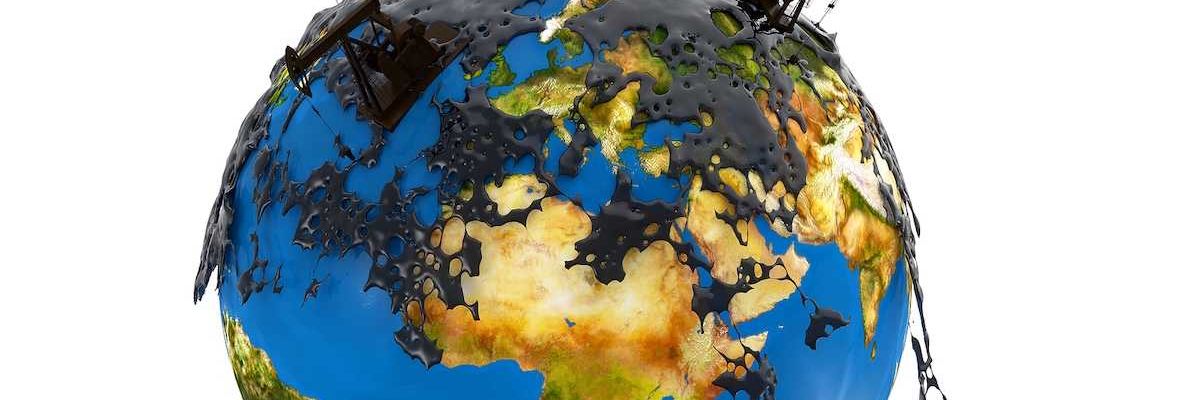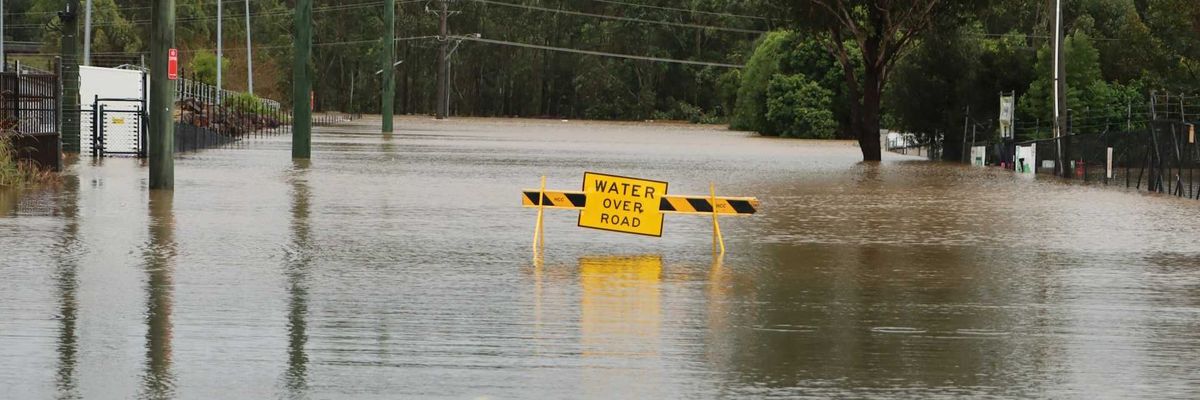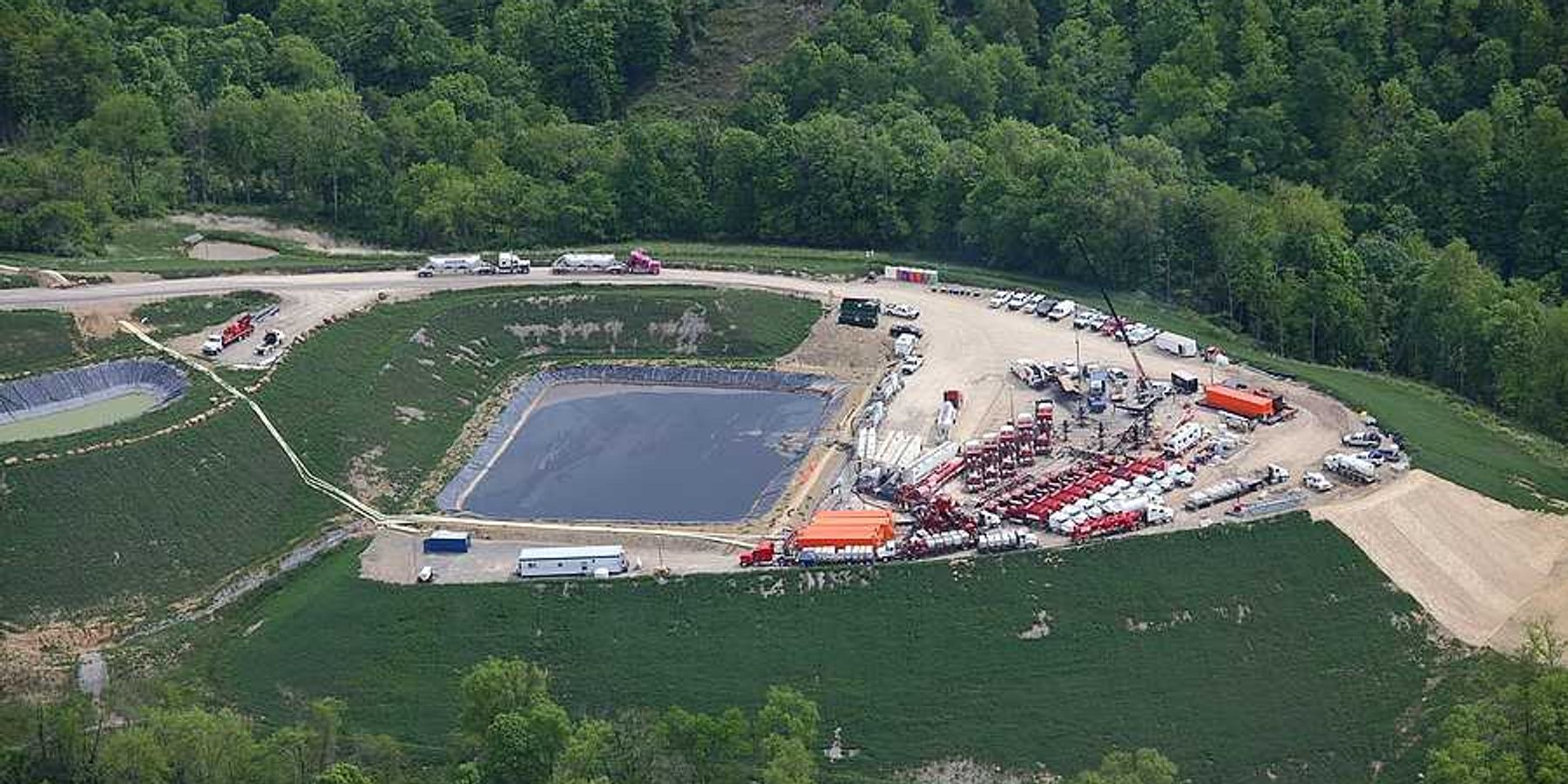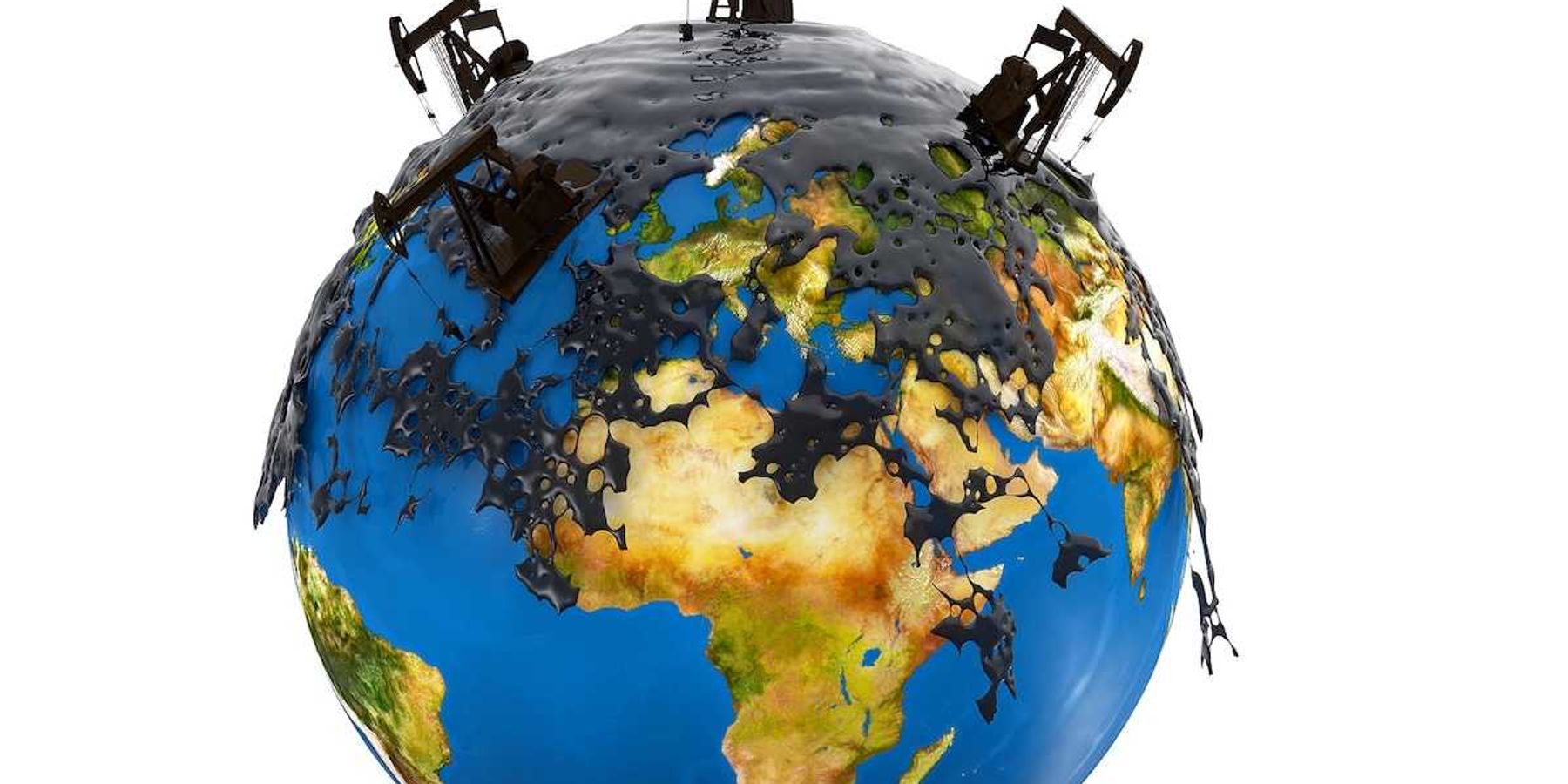antimicrobial
Factory farms put climate at risk, experts say in urging World Health officials to speak out.
In a letter, 200 experts called on the next director-general of the World Health Organization to confront the role factory farming plays in climate change.
Roughly 200 experts in disciplines from nutrition to animal welfare are calling on the World Health Organization to take a more serious look at the impact of industrial livestock production on human health and the climate.
In a letter sent Monday, the group—which includes former New York Times food writer Mark Bittman and environmentalist Bill McKibben—appealed to the WHO, asking that its next director-general work "to reduce the size and number of factory farms." The WHO's World Health Assembly got underway Monday, and the body will elect a new leader this week.
"As the global health community acknowledges the intertwined nature of planetary and human health, it must also confront the role that factory farming plays in climate change," the letter says.
The group points to predictions that, without a reduction in meat consumption, agriculture—including livestock production and growing grain to feed livestock—is on track to gobble up half the world's carbon budget if countries expect to meet the 2050 target of limiting global temperature rise to less than 2 degrees Celsius. The livestock industry's contribution to greenhouse gases come from direct sources, including methane emitted from the animals belching and their manure, but also from indirect sources, including land conversion and deforestation linked to growing feed.
The U.S. Environmental Protection Agency says that agriculture, including livestock production, is responsible for 9 percent of overall greenhouse gas emissions. The United Nations Food and Agriculture Organization (FAO) gives a higher global number, estimating that livestock production accounts for about 14.5 percent of all human-caused emissions, or about 7.1 gigatons of carbon dioxide or its warming equivalent.
Sara Place, who works on sustainable beef production for the National Cattlemen's Beef Association, said Monday that the letter's points about the impact of the beef industry globally misrepresents the U.S. beef industry, the world's largest producer.
"In the U.S., direct emissions from beef, in terms of methane emissions, was 1.9 percent of U.S. emissions," Place said, citing 2014 numbers from the EPA. "Transportation is 25 percent of our emissions. Numbers that are accurate at the global level don't necessarily apply to the U.S."
While short on policy recommendations and details, the letter suggests that advocacy groups and academics are going to push the issue at a global level.
"The letter highlights the interconnectedness of health, climate and meat consumption. They're overlapping issues," said Sunjatha Bergen, a food and livestock specialist at the Natural Resources Defense Council. "This is an issue that the WHO should look at."
Globally, meat consumption has increased over the past 40 years, particularly in developing countries as incomes have risen, according to the FAO. The letter points to data indicating that factory farms have served this increased demand, especially for poultry and swine—but it says this surge in production has come at a cost to health and the environment.
The group's primary focus is on the growing problem of antimicrobial resistance, which it calls a "major threat to global health." The WHO predicts that, globally, the use of antibiotics in animal production is expected to rise 70 percent between 2010 and 2030. Studies have shown that a rise in use of antibiotics that are medically important to humans is contributing to antimicrobial resistance, which can render antibiotics useless even against relatively minor illnesses. If current trends continue, the letter says, drug-resistant bugs could kill up to 9.5 million people a year by 2050.
The group also addresses the link between meat consumption and obesity and illness. Last year, the WHO issued a report that declared consumption of red meat to be "probably carcinogenic to humans" and processed meat to be "carcinogenic to humans."
"The bottom line is that factory farm production isn't great for the climate, especially the disproportionate impact of red meat," Bergen said. "If we reduce demand, that will have a big impact on global warming. Even if they do it for health reasons, that will have a positive impact on the environment."
Bergen said a conclusion by the WHO wouldn't lead to any kind of enforceable policy.
"It's more the moral leadership," she said. "You take it seriously when they've weighed in."
Meet the obscure microbe that influences climate, ocean ecosystems, and perhaps even evolution.
Penny Chisholm has spent decades revealing the secrets of the marine microbe Prochlorococcus.
By Elizabeth PennisiMar. 9, 2017 , 8:00 AM
Penny Chisholm has had a 35-year love affair—with a microbe. For her, it's been the perfect partner—elusive during courting, a source of intellectual fulfillment, and still full of mystery decades after their introduction during an ocean cruise.
Penny Chisholm made a photosynthesizing microbe called Prochlorococcus (green) her life's work.
PHOTO: KEN RICHARDSON
To look at, the object of her passion is just a green mote, floating in vast numbers in the world's oceans. But Chisholm has found hidden complexity within Prochlorococcus, a cyanobacterium that is the smallest, most abundant photosynthesizing cell in the ocean—responsible for 5% of global photosynthesis, by some estimates. Its many different versions, or ecotypes, thrive from the sunlit sea surface to a depth of 200 meters, where light is minimal. Collectively the "species" boasts an estimated 80,000 genes—four times what humans have, and plenty to deal with whatever the world's oceans throw at it. "It's a beautiful little life machine and like a superorganism," Chisholm says. "It's got a story to tell us."
And tell it Chisholm has, to anyone and in any way possible. Her work on the microbe has led to a meeting with a U.S. president, a debate with the Dalai Lama, and co-authorship of science-themed children's books. She even once tried to get the hip-hop star GZA to incorporate the bacterium's mouthful of a name into a rap song for an album he was considering on oceans. "She's really driven to sell Prochlorococcus," says Allison Coe, Chisholm's longtime lab manager. "She wants everyone else to be as passionate and to consider it as amazing as she thinks it is."
The microbe's long climb to recognition mirrors Chisholm's own. Early in her career, as the lone woman, and lone biologist, in the civil engineering department at the Massachusetts Institute of Technology (MIT) in Cambridge, she had to overcome both scientific and cultural hurdles, adopting the latest techniques to reveal Prochlorococcus's secrets while working with other female faculty to get MIT to address gender discrimination. Her quiet persistence inspired others. Chisholm, who in recent years has been awarded the National Medal of Science and named as one of MIT's 13 Institute Professors, sent "an important message for future academicians," says Heidi Sosik, a biological oceanographer at the Woods Hole Oceanographic Institution (WHOI) in Massachusetts. "You don't have to be a blustery, high-profile white guy to make it."
The stature of her microbial partner continues to grow as well. Its influence over climate is now appreciated, for example. And Chisholm and two colleagues will soon lay out evidence for a scenario in which Prochlorococcus is a central actor in evolution. They propose that it is not only responsible for much of the oxygen we breathe today, but also fueled the explosion of early life in the oceans and the ancient rise in oxygen in Earth's atmosphere. As MIT oceanographer Mick Follows put it, Chisholm "has beautifully shown us how this microbe works and how the ocean world is organized."
A microbe's vital stats
PHOTO: N. WATSON AND L. THOMPSON, MIT
Chisholm says that as a woman of her times, she went to college in the 1960s mainly "to find a husband." Nevertheless, as an undergrad, she explored the chemistry of lakes, and—after a professor pushed her—decided to pursue a Ph.D. At the State University of New York in Albany, she studied the 24-hour variation in nutrient cycling in Euglena, a single-cell photosynthesizer like Prochlorococcus, but found in freshwater. She next went to the Scripps Institution of Oceanography in San Diego, California, for a very practical reason—there was more funding for marine microbial ecology than for freshwater.
In 1976, MIT came calling. At the time, its civil engineering department was looking to become more "environmental" by hiring a microbiologist, a trend already evident in many similar departments elsewhere. She accepted but was so convinced she wouldn't get tenure it took many years for her to consider buying a house. It was easy to see why she might not fit in. An old department photo shows a petite, young blonde among a sea of mostly middle-aged white men. Furthermore, the other biologists on campus had a biomedical or molecular bent, quite unlike the fuzzy ecological world she was diving into.
But MIT, through its affiliation with WHOI on Cape Cod, offered Chisholm a chance to go to sea, looking for answers to a question that had begun to captivate her: how microbes influence the ocean. "She had this idea there were new things to discover and [scientists] just needed to find ways of observing the ocean at higher and higher resolution," says Alexandra Worden of the Monterey Bay Aquarium Research Institute in Moss Landing, California, who studies the evolution of ocean microbes.
In the 1980s most of the ocean's freefloating organisms, or plankton, went virtually unseen because they were too small to detect in a light microscope. But other researchers had identified a handful of photosynthetic marine bacteria. Chisholm and her first postdoc Robert Olson decided to sieve seawater with a flow cytometer, a laboratory device that uses a laser to view and sort individual cells, to learn more about them. With it, Olson noticed an unexpected red fluorescing signal so small that they first thought it was electronic noise. But the signal varied depending on the depth and temperature of the water sample being analyzed, suggesting it might come from something alive.
Chisholm wasn't satisfied that they had found a new life form until collaborators photographed the tiny cells under an electron microscope and another group had traced the red signal to the microbe's chlorophyll and other pigments. In 1988, they published their discovery. By 1992, when they named it Prochlorococcus, the "primitive green berry," they realized that they were not the first to see the microbe. But no one had recognized that it represented a new organism. "We were in the right place at the right time with the right instruments to have these cells say who they were," Chisholm says.
For years, because no one could keep Prochlorococcus alive in a lab, the only way to study it was at sea. And even though Brian Palenik, now an oceanographer at Scripps, was finally able to grow it in a test tube in 1990, it took another 10 years before anyone could sustain the pure cultures needed for many experiments. Even today, no one has been able to manipulate Prochlorococcus genetically, a standard approach to studying other organisms.
Despite these challenges, Chisholm was quickly seduced by her team's discovery, suspecting that this simple, abundant organism might be a major player in marine ecology. But just as her relationship with Prochlorococcus was starting to flourish, Chisholm took a detour onto a more public stage, after receiving a call that, she says, "changed my life." Nancy Hopkins, an MIT cancer researcher she casually knew, felt that the school was discriminating against female faculty in lab space, pay, and support. Hopkins had written a letter calling for an investigation and wanted more backers. Chisholm had never considered herself a feminist or activist, but like all but one of the 17 other senior female faculty at the time, she signed on. "We were really upset that things were not changing for women," Chisholm recalls.
They took their concerns to an MIT dean in 1995 and got backing for an investigative committee to collect data on the number of teaching and administrative positions held by women, salaries, sizes of labs, and more. "[Penny] was one of the ones who brought a more positive, ‘Let's figure this out’ approach," says biogeochemist Diane McKnight of the University of Colorado in Boulder, an alumna of Chisholm's lab.
As a graduate student Chisholm studied Euglena, a freshwater photosynthesizing microbe, before setting sights on Prochlorococcus.
PHOTO: STATE UNIVERSITY OF NEW YORK IN ALBANY ARCHIVES
After working behind the scenes for almost 2 years, the committee made a series of recommendations that the MIT administration quickly embraced. When a summary of the investigation made it into the media in 1999, "it was a shot heard around the world," Chisholm recalls. "It became a big movement." MIT's leaders responded constructively, she adds. "Looking back at the way things were when I first got here and how things are now, there's a tremendous shift," she says.
After helping raise the profile of female scientists, Chisholm drew new attention to her favorite microbe. As she and her students and postdocs grew samples under varied conditions in the lab, they identified five main Prochlorococcus ecotypes, each adapted to a different combination of light and temperature. In her lab's growth chambers, they are easy to tell apart: Some are bright green, whereas others have a yellowish hue. Each makes a different light-absorbing pigment so that at its particular depth, "it is the most efficient photosynthetic machine," Chisholm says.
When the U.S. Department of Energy's Joint Genome Institute first began sequencing microbes in 2003, Chisholm convinced it to sequence two Prochlorococcus strains—this at a time when sequencing a single microbe was a big deal—so she could assess genetic differences between the forms adapted to low and high light levels. "That was very greedy of me," she smiles. Her team found the high light–adapted ecotype's genome was very streamlined—1.7 million bases with just 1700 genes. "It's one of, if not the, simplest self-sustaining organism we know of," says Chisholm's postdoc Jamie Becker. The low-light version's genome has 2.4 million bases, with 2275 genes, including some that may enable the microbe to work best in low light and avoid damage from the sun should it wind up at the surface somehow.
As new molecular technologies arose—microarrays that document gene activity and proteomics methods that look at the proteins present, for example—Chisholm and her students and postdocs were quick to learn and apply them. She credits them for all her successes. "When I say ‘we’ I mean ‘they,’" she remarked at a lecture on her life's work. When undergraduate Jed Fuhrman worked in her lab and contributed to a paper published in Nature, "she had no trouble just handing off the first authorship even though she was a new professor" and wrote most of the paper, he recalls. (Fuhrman is now a biological oceanographer at the University of Southern California in Los Angeles.)
Together, her lab found that each of the main Prochlorococcus ecotypes has its own genomic "island," a patch of genes that confers specific adaptations to an environment. One island helps the microbe survive in very low-phosphorus waters, for example. Bacteriophages, viruses that infect bacteria and can either pick up or deposit genetic material, may move these islands and other genes between ecotypes, Chisholm's postdoc Debbie Lindell proposed in 2004, thereby ensuring the microbes can adapt to changing conditions.
Chisholm's lab remained small until about 15 years ago, when the mounting evidence that ocean microbes are major players in the biosphere persuaded three foundations—Seaver, Gordon and Betty Moore, and Simons—to pour millions into studying them. The lab grew from a handful of researchers to dozens, who not only could spend weeks at sea, sampling and collecting data, but could also return to the lab to try innovative ways of probing how the microbe worked. "That's when everything got exciting," Chisholm says.
The worldwide sampling showed that the five primary ecotypes didn't begin to capture Prochlorococcus's diversity. Sequencing revealed hundreds of strains coexisting even in just a milliliter of seawater, each with more than 100 distinctive genes. And when it became possible to sequence genomes from single cells—a technique Chisholm's lab pioneered for marine microbes—each strain turned out to encompass still more genetic variation. "It's not one bug, it's a whole family of things that grade into each other," says Olson, now at WHOI.
Although each cell has only about 2000 genes, Prochlorococcus as a whole has a "pan-genome" of perhaps 80,000 genes, Chisholm and her colleagues estimate. "That's a ton of information for these little guys," she says, and it must be the secret of Prochlorococcus's success. Its enormous genomic repertoire enables it to cope with conditions across a vast swath of the oceans, dominating warm seas from 40° North to 40° South (see map, below).
The sea's invisible pasture
Drawing on ocean and marine microbe data collected by Massachusetts Institute of Technology researchers, this model depicts the most dominant types of phytoplankton in the world's oceans, with Prochlorococcus ruling much of the globe and bigger diatoms dominating nearer the poles.
IMAGE: MIT DARWIN PROJECT, ECCO2, MITGCM/OLIVER JAHN (MIT), CHRIS HILL (MIT), MICK FOLLOWS (MIT), STEPHANIE DUTKIEWICZ (MIT), DIMITRIS MENEMENLIS (JPL)
These waters contain an estimated 3 billion billion billion Prochlorococcus cells, collectively weighing as much as 220 million Volkswagen Beetles. That abundance makes the microbe a heavyweight in ocean food webs and climate. It is a key source of food in the nutrient-poor regions of the ocean where it flourishes, Becker says. "Prochlorococcus makes organic matter that other microorganisms eat." And because of its role in the carbon cycle, the microbe significantly regulates levels of climate-warming carbon dioxide (CO2), Chisholm says.
Yet Chisholm is uncomfortable with proposals to stem global warming by manipulating the ocean's life to capture more CO2. In 2001, she vigorously spoke out against proposals to fertilize the oceans with iron to stimulate phytoplankton growth, coauthoring a paper in Science that warned of possible unforeseen consequences. Years later, in 2012, she publicly debated the Dalai Lama's "let's try it" position when the two were on a panel at MIT.
Despite her current visibility, Chisholm still feels much of the insecurity that burdened her early in her career. When she was named an Institute Professor, for example, she wondered, "How could this be?" she recalls. "I don't feel like that kind of person."
A sense of being an imposter, she admits, continues to dog her. She still works long hours—"I could never juggle [so] many things," Coe says. "But the older she gets the more worried she gets." In 2013, Chisholm's anxiety about the lab and the future of her Prochlorococcus cultures if she retires was so palpable she began to develop minor health problems. Starting tai chi lessons gave her a new perspective. "I needed to do something to get me out of my head," she recalls. She has also found an outlet, with artist and author Molly Bang, writing children's science books, featuring the sun as the narrator. One tells the story of the "invisible pasture of the sea."
She continues to be driven to unravel the story of Prochlorococcus. In 2014, for example, electron micrographs taken in her lab revealed tiny vesicles budding off Prochlorococcus cells; later, her postdoc Steven Biller showed that each cell releases two to five lipid-membrane bubbles filled with DNA and RNA per generation—possible food sources for other plankton, decoys for viruses, gene-transfer vehicles, or even messengers that communicate with other microbes. Biller has since found that other marine bacteria make these vesicles as well. "This was a whole new feature of the ocean ecosystem," Chisholm says.
In another hint that Prochlorococcus builds extensive partnerships with other marine microbes, Chisholm's lab found that it secretes a broad variety of peptides, or short protein fragments, that in other organisms have antimicrobial or signaling activity. Prochlorococcus has as many as 1500 different peptides per cell, according to work by Andres Fernando Cubillos-Ruiz, now a postdoc at MIT in another lab. The peptides appear to provide food for other very abundant ocean microbes and some of those in turn secrete an enzyme that detoxifies reactive oxygen molecules. Prochlorococcus doesn't make that enzyme itself but may be able to take it in from the surrounding water. The peptides may also signal other microbes in the surrounding waters—although what messages they carry is unclear. "I continue to be humbled by the major things we learn from Prochlorococcus that change the way we think about oceans," Chisholm says.
The tiny, mighty bacterium could also change thinking about life on land. Chisholm's postdoc Rogier Braakman has pieced together Prochlorococcus's evolutionary history, drawing on the genes active in different ecotypes and the conditions in which they live. Braakman is examining whether the microbe's metabolic activity hundreds of millions of years ago could have helped pave the way for life to explode outside of the oceans by drawing down atmospheric carbon dioxide and increasing oxygen in the air. This scenario has plenty of questions, Chisholm says, but its potential importance "makes it worth spending the time to connect the dots."
At 68, she is eager to keep making those connections. "I should probably be thinking about retiring, but I'm not because Prochlorococcus is too darn interesting," Chisholm says. "I'm really very grateful to have this organism in my life."
The EU’s promotion of meat consumption is misguided, Mr Hogan.
Ever since he took office, Agriculture Commissioner Phil Hogan has promoted the interests of the livestock sector while ignoring health and environmental warnings related to over-consumption of meat.
Home | Agriculture & Food | Opinions
DISCLAIMER: All opinions in this column reflect the views of the author(s), not of EurActiv.com PLC.
By Olga Kikou | Compassion in World Farming (CIWF) 20-10-2016 (updated: 20-10-2016 )
Phil Hogan, EU Agriculture Commissioner, at the launch and first meeting of the Meat Market Observatory.[© European Union , 2016]
Print Comments
Ever since he took office, Agriculture Commissioner Phil Hogan has promoted the interests of the livestock sector while ignoring health and environmental warnings related to over-consumption of meat, writes Olga Kikou.
Olga Kikou is European Affairs Manager at Compassion in World Farming, an international NGO working on the welfare of farm animals and sustainable farming and food.
In a recent speech at the annual Sommet de l’Elevage in Clermont-Ferrand, France, Agriculture Commissioner Phil Hogan promised to fight lower meat consumption by introducing measures to promote beef consumption in the European Union. He actually pledged €15 million intended for the internal European market while reacting against the negative publicity surrounding meat, the bad treatment of animals and meat’s detrimental impact on human health, which he contested.
Commissioner Hogan has defined his role within very narrow parameters, catering to the meat sector while ignoring scientific advice and public concerns. Engaged in efforts to increase production, open new markets for producers and encourage exports, his drive to increase meat consumption in Europe is the latest attempt to boost a sector which, according to FAO, is one of the most important contributors to a series of environmental problems related to greenhouse gas emissions and climate change, deforestation, loss of biodiversity and wildlife, water scarcity and pollution, and land degradation. So many valuable resources are being depleted and wasted because of policies that keep the farming industry happy. The production of beef meat in particular, is associated with serious problems, which will never be solved if the Commission proceeds with the business as usual model.
The high levels of meat consumption in the EU have been made possible by industrial farming, which actually threatens food security with its high resource use, increases in crop land and land use change, excessive use of water, fertilizer and feed. The production of animal feed in particular, is a form of food waste since land that could be used to feed people, especially in the developing world, is used to fatten animals instead, which constitutes a highly inefficient use of these crops and exacerbates poverty. Unfortunately, much of EU agriculture is dependent on feeding human-edible cereals to animals.
Over-consumption of animal protein increases the risk of food-related non-communicable diseases and can lead to obesity, diabetes, heart disease and certain cancers in humans. The World Health Organisation recently classified processed meats as carcinogenic and red meats as probably carcinogenic. Furthermore, overuse of antibiotics in livestock production contributes to the development of antimicrobial resistance. The animal agriculture sector is responsible for much of the antibiotic use in the world today. New data published by the European Medicines Agency (EMA) reveals that many European countries are failing to put an end to massive overuse of antibiotics in farming. Use of antibiotics in Europe remains more than twice as high in animals as in humans.
Besides ourselves, our meat eating habits have damaging consequences for other animal life on this planet. Industrial farming is detrimental to the welfare of farm animals. Tens of billions of land animals are raised for food every year, close to 8 billion in the EU alone. Despite the Treaty for the Functioning of the European Union (2009) which recognises animals for their own intrinsic value, in reality, farm animals are currently being treated as nothing more than commodities.
Despite EU bans on some forms of extreme cruelty, such as the severe confinement of animals, EU laws fall far short of what is necessary to bring the farming sector to the 21st century. Many farm animals are not covered by species specific legislation and there are serious, ongoing problems associated with many farming practices and with transport and slaughter of animals across Member States. Farm animal suffering is actually a European reality but the European Commission has been very reluctant to pursue full enforcement of existing legislation across the EU. During this current term, we actually experience a shift away from urgently needed legislation proposals, resulting in an actual stagnation of progress in the field of animal welfare.
However, the heavy toll associated with the over production and consumption of animal products has been recognised by the scientific community. Investors have taken notice too. Briefing papers such the FAIRR initiative, make the case for protein diversification, with an emphasis on promoting plant based proteins. Already people are talking about a ‘snowball effect’. The latest example came a few days ago when Tyson Foods, the world’s largest processor and marketer of chicken, beef and pork, announced that they have started investing in plant based foods. The “fast growing segment of plant based protein” has already attracted many entrepreneurs, such as Bill Gates, Twitter founders Biz Stone and Evan Williams, and venture capital firms in Silicon Valley and elsewhere, who have invested in the development of meat analogues and meat alternatives. It is estimated that demand for meat substitutes will grow significantly over the next few years.
It is clear that the future of food and agriculture lies far beyond the walls of the Commission and its Directorate for Agriculture and Rural Development. It lies in all those involved in the sustainable food movement, the loose-knit coalition of environmental, animal welfare, public health, farming, consumer and development groups who have been asking for an urgently needed, radical reform of the Common Agricultural Policy, a policy accountable for nearly 40% of the EU budget. It lies in companies that build on developing trends and explore many available opportunities, moving away from current EU policies of excessive meat production and consumption. It lies in the public’s positive attitudes toward animals and the shift toward more sustainable and compassionate choices. It lies in consumers who with their buying power can and will demand a transition to better diets and quality food for themselves and their families.
Pledging public funds to support a sector with such negative impact across so many areas is short sighted and dangerous. It’s time the Commission takes seriously the compelling evidence and scientific advice for a significant reduction in meat consumption and uses the opportunity to shift policies towards more sustainable ways of farming, encouraging farmers and consumers alike to transition to healthier and responsible choices.









